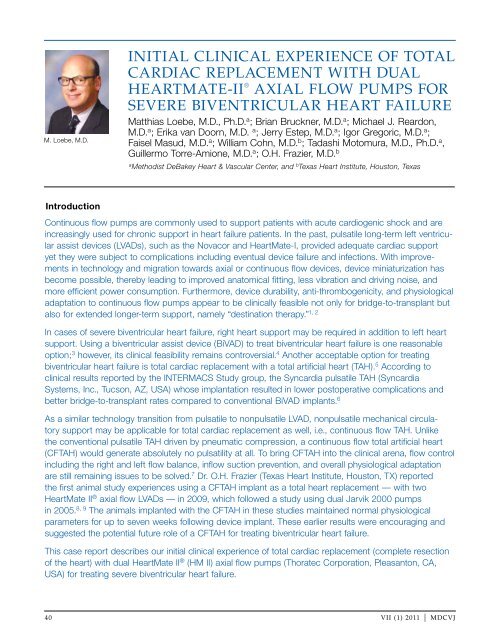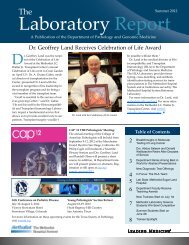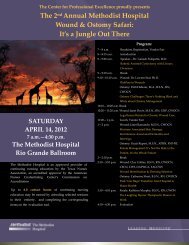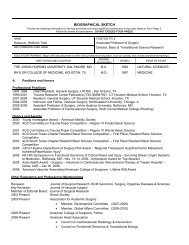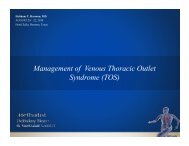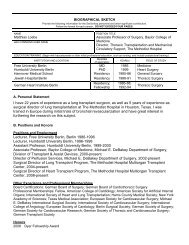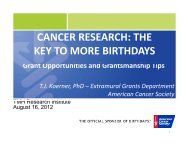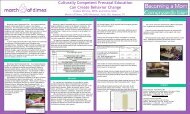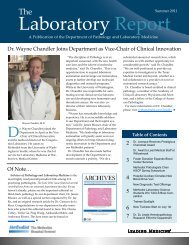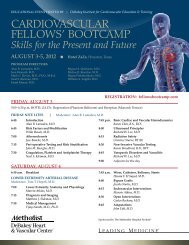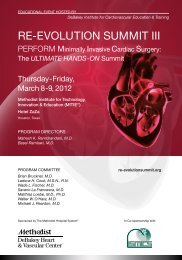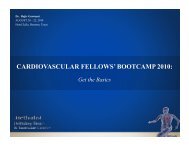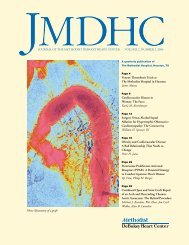DeBAKEy CARDIOvASCuLAR JOuRNAL - Methodist Hospital
DeBAKEy CARDIOvASCuLAR JOuRNAL - Methodist Hospital
DeBAKEy CARDIOvASCuLAR JOuRNAL - Methodist Hospital
You also want an ePaper? Increase the reach of your titles
YUMPU automatically turns print PDFs into web optimized ePapers that Google loves.
M. Loebe, M.D.<br />
Introduction<br />
INITIAL CLINICAL EXPERIENCE OF TOTAL<br />
CARDIAC REPLACEMENT WITH DuAL<br />
HEARTMATE-II ®<br />
AXIAL FLOW PuMPS FOR<br />
SEvERE BIvENTRICuLAR HEART FAILuRE<br />
Matthias Loebe, M.D., Ph.D. a ; Brian Bruckner, M.D. a ; Michael J. Reardon,<br />
M.D. a ; Erika van Doorn, M.D. a ; Jerry Estep, M.D. a ; Igor Gregoric, M.D. a ;<br />
Faisel Masud, M.D. a ; William Cohn, M.D. b ; Tadashi Motomura, M.D., Ph.D. a ,<br />
Guillermo Torre-Amione, M.D. a ; O.H. Frazier, M.D. b<br />
a <strong>Methodist</strong> DeBakey Heart & Vascular Center, and b Texas Heart Institute, Houston, Texas<br />
Continuous flow pumps are commonly used to support patients with acute cardiogenic shock and are<br />
increasingly used for chronic support in heart failure patients. In the past, pulsatile long-term left ventricular<br />
assist devices (LVADs), such as the Novacor and HeartMate-I, provided adequate cardiac support<br />
yet they were subject to complications including eventual device failure and infections. With improvements<br />
in technology and migration towards axial or continuous flow devices, device miniaturization has<br />
become possible, thereby leading to improved anatomical fitting, less vibration and driving noise, and<br />
more efficient power consumption. Furthermore, device durability, anti-thrombogenicity, and physiological<br />
adaptation to continuous flow pumps appear to be clinically feasible not only for bridge-to-transplant but<br />
1, 2<br />
also for extended longer-term support, namely “destination therapy.”<br />
In cases of severe biventricular heart failure, right heart support may be required in addition to left heart<br />
support. Using a biventricular assist device (BiVAD) to treat biventricular heart failure is one reasonable<br />
option; 3 however, its clinical feasibility remains controversial. 4 Another acceptable option for treating<br />
biventricular heart failure is total cardiac replacement with a total artificial heart (TAH). 5 According to<br />
clinical results reported by the INTERMACS Study group, the Syncardia pulsatile TAH (Syncardia<br />
Systems, Inc., Tucson, AZ, USA) whose implantation resulted in lower postoperative complications and<br />
better bridge-to-transplant rates compared to conventional BiVAD implants. 6<br />
As a similar technology transition from pulsatile to nonpulsatile LVAD, nonpulsatile mechanical circulatory<br />
support may be applicable for total cardiac replacement as well, i.e., continuous flow TAH. Unlike<br />
the conventional pulsatile TAH driven by pneumatic compression, a continuous flow total artificial heart<br />
(CFTAH) would generate absolutely no pulsatility at all. To bring CFTAH into the clinical arena, flow control<br />
including the right and left flow balance, inflow suction prevention, and overall physiological adaptation<br />
are still remaining issues to be solved. 7 Dr. O.H. Frazier (Texas Heart Institute, Houston, TX) reported<br />
the first animal study experiences using a CFTAH implant as a total heart replacement — with two<br />
HeartMate II ® axial flow LVADs — in 2009, which followed a study using dual Jarvik 2000 pumps<br />
in 2005. 8, 9 The animals implanted with the CFTAH in these studies maintained normal physiological<br />
parameters for up to seven weeks following device implant. These earlier results were encouraging and<br />
suggested the potential future role of a CFTAH for treating biventricular heart failure.<br />
This case report describes our initial clinical experience of total cardiac replacement (complete resection<br />
of the heart) with dual HeartMate II ® (HM II) axial flow pumps (Thoratec Corporation, Pleasanton, CA,<br />
USA) for treating severe biventricular heart failure.<br />
40 vII (1) 2011 | MDCvJ


